Pillars of Heracles
Q152854Pillars of Heracles (Greek: Ἡράκλειαι Στῆλαι): ancient name for the narrow strait that connected the Mediterranean Sea and the Atlantic Ocean, identical to the modern Strait of Gibraltar.
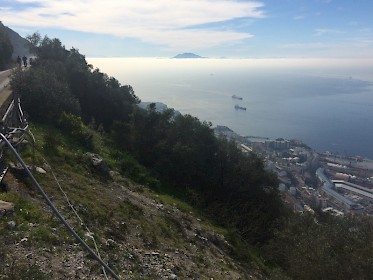
"Pillars of Heracles" was the ancient name of the strait, fourteen kilometers wide, between the Mediterranean Sea and the Atlantic Ocean (the Fretum Gaditanum, modern Strait of Gibraltar). Mediterranean sailors who had passed the Pillars of Heracles would reach Gadeira, modern Cádiz, the first Phoenician colony outside the Mediterranean.note Here was a famous sanctuary of the god Melqart, who was known to the Greeks as Heracles, because both gods were represented wearing a lion-skin. The Greeks connected Gadeira with the Red Island where Heracles had stolen the Cattle of Geryon.
Columns and Promontories
There was no consensus about the way the story of Heracles-Melqart was connected to the Pillars; nor was there consensus about their nature. The Graeco-Roman geographer Strabo of Amasia summarizes various theories.note The people in Iberia and Africa, he says, think that the Pillars are to be found in Gadeira, while "Dicaearchus and Eratosthenes and Polybius and most of the Greeks" think that they are the two promontories to the south and north of the Strait of Gibraltar.
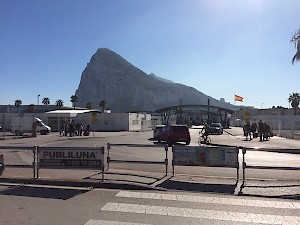
Modern scholars identify the northern promontory, Calpe, with the Rock of Gibraltar, while the southern pillar, Abilyx or Mons Abila, cannot be identified with any certainty. There are two candidates: the Jebel Musa in the northernmost part of what is now called Morocco and the Monte Hacho in the Spanish exclave of Ceuta, eleven kilometers to the east.
Although "most of the Greeks" were convinced of this, they did not know what Heracles had to do with it. The Roman author Seneca, who had family ties to Cordoba in southern Spain and may record a local tradition, believed that the demigod had split a mountain and opened the strait.note A younger contemporary of Seneca, Pliny the Elder, repeats this story.note On the other hand, an older writer, Diodorus of Sicily, believed that Heracles had drawn the two promontories together to narrow the strait and keep Oceanic monsters outside the Mediterranean.note
The Columns of Melqart
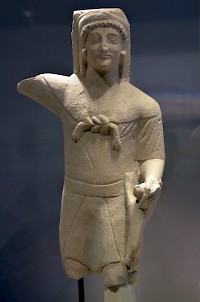
A third theory, also mentioned by Strabo and attributed to Posidonius, refers to the temple of Melqart in Gadeira. In the temple domain stood two bronze pillars of eight cubits.note (A later writer, Philostratus, says they were "made of gold and silver... over a cubit high, of square form, resembling anvils.note) Although we do not know the meaning of these pillars, there are several parallels from the Near East, which prove that it was quite common to have two columns in front of a sanctuary. For instance, the Greek researcher Herodotus mentions the twin columns in front of the temple of Melqart in Tyre: "one of pure gold and one of an emerald stone of such size as to shine by night".note
In the Great Court of the temple of Jupiter in Baalbek one can still see two columns, made of pink and grey granite. In the high place of worship in Sfiré, they were represented in relief next to the entrance. Most famous are the two bronze pillars in front of the temple in Jerusalem, named Boaz and Jakin.note. It is certainly possible that the expression "Pillars of Heracles" originally referred to the columns near the temple of Melqart in Gadeira, apparently important in Phoenician religion, and were later understood to be the name of the two promontories to the south and north of the Strait of Gibraltar.
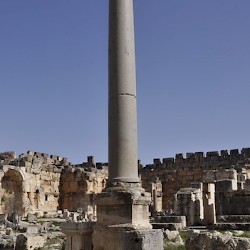 Baalbek, temple of Jupiter, Great Court, Northern column |
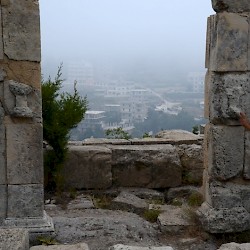 Sfiré, Temple D, Relief of two columns |
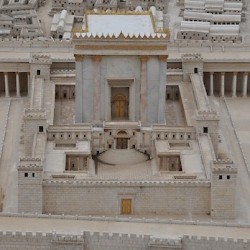 Jerusalem, Temple Complex, Temple, Model |
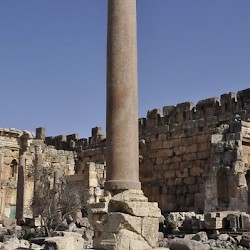 Baalbek, temple of Jupiter, Great Court, Southern column |
Other Pillars
According to the Roman author Tacitus, the Roman soldiers who served in the Lower Rhineland called the place where one of the branches of the Rhine emptied itself into the North Sea "the Pillars of Heracles".note Because Tacitus is describing the land of the Frisians — a very flat area — this must be a soldiers' joke about the dunes near the Roman naval base at Flevum.